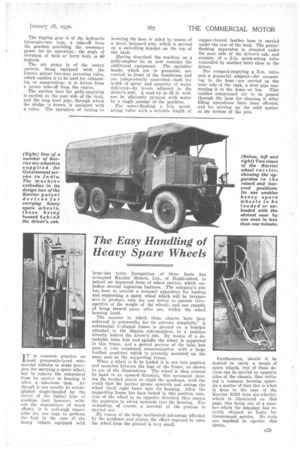The Easy Handling of Heavy Spare Wheels
Page 51

If you've noticed an error in this article please click here to report it so we can fix it.
IT is common practice on most pneumatic-tyred commercial vehicles to make provision for carrying a spare wheel, but to remove the component from its carrier or housing is often a -laborious task. Although it can usually be accomplished single-handed by the driver of the lighter type of machine (not, however, without the expenditure of much effort), it is well-nigh impossible for one man to perform the feat in the case of the heavy vehicle equipped with
large-size tyres. Recognition of these facts has prompted Karrier Motors, Ltd., of Huddersfield, to patent an improved form of wheel carrier, which embodies several ingenious features. The company's aim has been to provide a compact apparatus for loading and supporting a spare wheel Which will be inexpensive to produce, easy for any driver to operate (irrespective of the weight of the wheel), and one capable of being stowed away after use, within the wheel housing itself. The manner in which these objects have been achieved is noteworthy for its extreme simplicity:" A substantial U-shaped frame is pivoted on a bracket attached to the chassis side-members, in a position directly behind the driver's cab. By means of a detachable false hub and spindle the wheel is supported in this frame, and a geared portion of the false hub puts it into rotational communication with a large toothed quadrant which is pivotally mounted on the same axis as the supporting frame.
When a wheel is to be loaded it is run into position and mounted between the legs of the frame, as shown in one of the illustrations. The wheel is then rotated by hand in an upward direction this movement causing the toothed pinion to climb the quadrant, with the result that the carrier pivots upwards and swings the wheel itself right home into its housing. After the supporting frame has been locked in this position rotation of the wheel in an opposite direction then causes the quadrant to swing upwards into the housing. For unloa,ding, of course, a reversal of the process is carried out.
,By reason of the large mechanical advantage afforded by the quadrant and pinion, the effort required to raise the wheel from the ground is very small. Furthermore, should it he desired to carry a couple of spare wheels, two of these devices can be carried on opposite sides of the chassis, thus utilizing a common housing space. As a matter of fact this is what is done in the ease of the Karrier RAW type six-wheeler, which is illustrated on this page, this being one of a number which the company has recently shipped to India for Government service. No tools are required to operate this device.












































































































